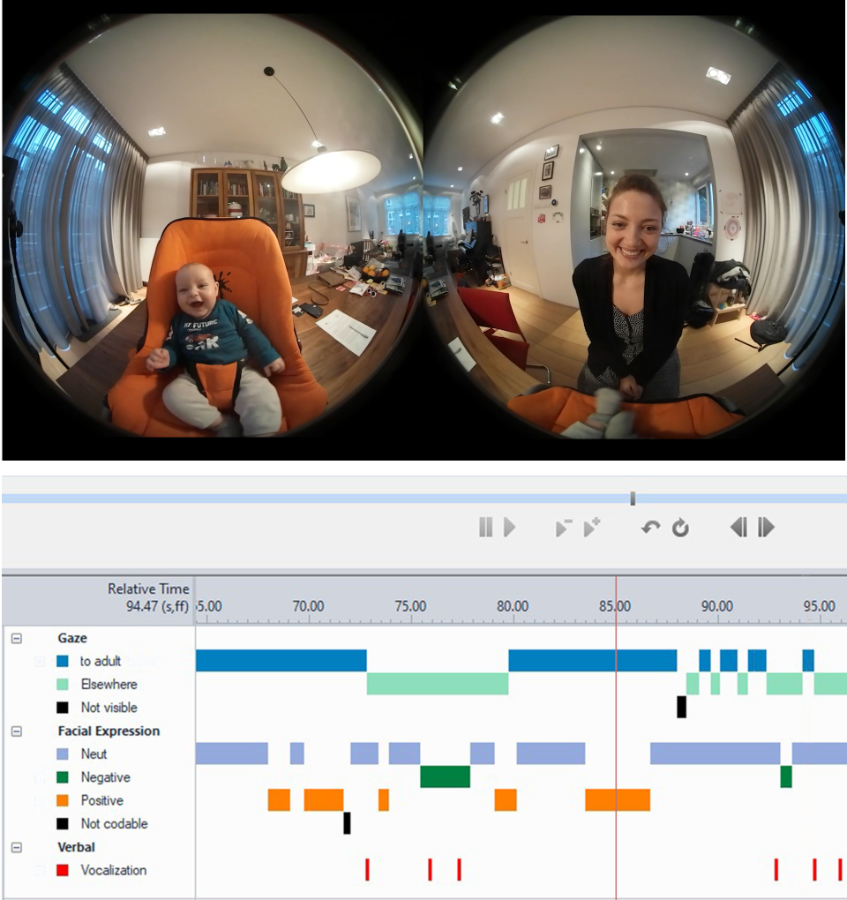How does communication with strangers develop?
Various factors contribute to shaping social-emotional developmental trajectories, such as familiarity of the interaction partner, the child’s age, but also individual predispositions, such as temperament.
Posted by
Published on
Thu 09 Jun. 2022
Topics
| Child Development | Developmental Psychology | Emotions | Infants | Parent-child Interaction | The Observer XT |

As a parent, you offer your child structure, and you give your child a lot of attention and positive affection. As a result, your child becomes attached to you, feels safe with you, and learns that it can rely on you.
Your child will increasingly notice the difference between familiar people he knows and trusts and strangers. At first, strangers may trigger some fear because of the novelty and uncertainty. However, despite this fear, eventually your child will engage in social interactions with strangers. How does this develop?
Social interaction development
Social interaction development concerns the child’s experience, expression, and regulation of emotions, and the ability to interact with others while learning social skills. This leads to social and emotional well-being, which are important conditions for children to function and learn well.
Various factors contribute to shaping social interaction developmental trajectories, for example, the familiarity of the interaction partner - as mentioned above, the child’s age, but also individual predispositions, such as temperament, which influences a child’s attention, emotions, and motions. Temperament contributes to the child’s reaction to the novel situation either in an excited, curious way, or in an irritated, stressed out, or sad way.
Children displaying high levels of temperamental surgency tend to elicit positive affect from interaction partners, thereby gaining access to a greater amount of social interactions than more introverted children. In children, surgency is an emotional dimension that is characterized by high levels of activity and positive emotion, impulsivity, and engagement with their environment.
FREE WHITE PAPER: Parent-child interaction
This free white paper informs you how on to facilitate a parent-child study and how to set up your experiment.
- Perform tests in a lab or in-home
- Collect data with video
- Design a coding scheme
How does communication with strangers develop?
In her PhD research, Eliala A. Salvadori wanted to know more about preverbal communication with strangers. Therefore, she designed a longitudinal study with these three goals:
- Examining differences in the development of infant visual, facial, and vocal communication patterns between strangers and each parent (mothers and fathers).
- Determining how individual differences in the development of infant communication with strangers (vs. mothers and fathers) are modulated by infant levels of temperamental reactivity.
- Examining concurrent and longitudinal associations between infant communication with strangers and each parent.
A sample of 58 children (25 girls, 33 boys) was included in this study. An innovative aspect of this study was the participation of both mothers and fathers.
Also read: 5 examples of infant studies
Observing interactions to assess emotional communication
At four and eight months of age, each infant was tested via naturalistic observations during home visits. In a random order, two-minute face-to-face interactions took place with the infant’s mother, father and the experimenter, to assess emotional communication.
Parents were instructed to interact with their infant as they would normally do. Experimenters were instructed to be visually attentive and expressively positive with the infant.
At four months of age, the infant was seated in an infant seat on the table, while at eight months of age the infant was seated in a high chair next to the table. In between the infant and the parent or experimenter was mounted a 360° camera to record the interactions (see figure 1).

Figure 1 - Example of the set ups
Coding gaze behavior, facial expressions, and vocalizations
With The Observer XT software, three components of the interactions were coded using a coding scheme for emotional communication:
- Gaze behavior: the direction the infant looked at (communication partner, elsewhere, not visible) | coded as a state event (duration in seconds).
- Facial expressions: using the categories positive, negative, neutral, and not visible | coded as a state event (duration in seconds).
- Vocalizations: comprehensively (i.e., positive, neutral, and negative vocalizations were aggregated) and separately for positively and negatively valenced vocalizations (i.e., vocalizations combined with a simultaneously occurring positive/negative facial expression) | coded as point events (frequency of occurrence).

Figure 2 - Visualization of the data streams in The Observer XT
To avoid observer bias, a senior coder randomly selected and double coded 15% of the observations. A high inter-rater reliability was found.
To measure infant temperament, both parents filled in a short, Dutch version of the Infant Behavior Questionnaire.
Partner-directed gaze behavior
The research team found that infants looked longer at strangers (female experimenters) than they did at their fathers during the interactions. Age seemed to have an effect here. The gaze duration was lower at eight months of age than at four months of age.
The researchers found no significant difference between infant gaze at mothers and strangers. It is possible that strangers and mothers interacted in a similar way with the infants and that as a result there was no difference in the infants’ gaze behaviors.
It is also possible that the infants were very interested in the unfamiliar (female) adult and curiosity caused the infants' visual involvement. Besides, the social interactions took place in the family's home, hence a familiar and safe environment, which may have influenced infants' visual patterns.
Negative affectivity was associated with lower levels of gaze, regardless of the identity of the interaction partner.
Levels of smiling and vocalizations
Interaction with mothers trigged the infant’s more smiles and sounds, as compared to the strangers. There were also more frequent infant vocalizations with fathers than with strangers at eight months, but not at four. So again, age played a role.
Temperamental surgency was associated with higher levels of positive affect and vocalizations with strangers and both parents (positive affect was particularly accentuated with mothers).
Interaction with strangers
In summary, the results of this study showed that infants gaze longer at strangers than at fathers, exhibit less smiling to strangers than to mothers, and produce fewer vocalizations with strangers than with either parent.
Temperament contributes to individual differences in infant communication with strangers and both parents over development: infants higher in surgency expressed more positive affect and vocalizations while infants higher in negative affectivity exhibited less positive affect and visual engagement.
FREE TRIAL: Try The Observer XT yourself!
Request a free trial and see for yourself how easy behavioral research can be!
- Work faster
- Reduce costs
- Get better data
References
Salvadori, E.A.; Colonnesi, C.; Elsammak, L.; Oort, F.J. & Messinger, D.S. (2022). Beyond the familial: The development of emotional communication with mothers, fathers, and strangers. Infancy, 1– 27. https://doi.org/10.1111/infa.12467
https://en.wikipedia.org/wiki/Surgency
Pictures created by E.A. Salvadori
Related Posts

Should you use a combination of modes to optimize behavioral studies?

Emotion analysis can be beneficial to researchers in decision making
